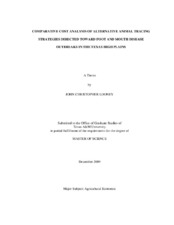| dc.description.abstract | The primary objective of this study is to evaluate the industry impact of a
hypothetical Foot and Mouth Disease (FMD) outbreak in the Texas High Plains using
alternative animal tracing levels. To accomplish this objective, an epidemiological
disease spread model, AUSSPREAD, is used to simulate the FMD outbreak and an
economic model is used to examine the impacts of different animal identification levels
in cattle. The different levels of animal identification relate to the model?s ability to
trace back the subsequent infected and/or dangerous contacts with which the initial
outbreak herd has been in contact. The study examines direct disease management costs
(slaughter, euthanasia, disposal, surveillance, and cleaning disinfection), forgone
income, and other indirect costs (indemnity payments and welfare slaughter) for
outbreaks originating from a large beef operation, a feedlot, and a saleyard across
subsequent tracing periods from 1 to 10 days. Welfare slaughter and quarantine costs
were estimated for the best and worst outbreaks from the feedlot operation. It is
noteworthy that total direct costs of a FMD outbreak would be more extensive than the
current study's calculations, which only analyzed the direct disease management costs.
The increased days to trace dangerous contacts presented overall increases in
outbreak losses over each outbreak scenario. Although outcome averages appear
insensitive at times under the assumptions applied, the epidemiological model presented
the possibility that traceability could reduce the risk of extreme outcomes in respect to
the overall distribution of losses. For each cattle operation, the outbreaks stayed
consistent or marginally increased with their respective average costs, but their
maximum losses rose steadily, across the trace periods examined. The impact of
increased traceability and decreased outbreak length can be justified in affecting FMD
outbreak costs in a positive manner. The results provide the industry with estimations of
different outbreak scenarios which can be used to inform the decision on the NAIS
system. Longer tracing periods, larger simulations (by iteration), and further study of the
model is necessary in order to more accurately imitate FMD outbreaks within the Texas
High Plains and its detrimental effects. | en |


